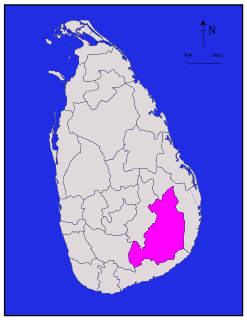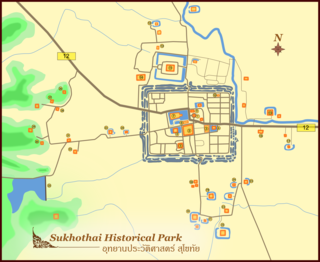
Sukhothai Historical Park covers the ruins of Sukhothai, literally 'dawn of happiness', capital of the Sukhothai Kingdom in the 13th and 14th centuries, in north central Thailand. It is near the city of Sukhothai, capital of Sukhothai Province.

Bulguksa is located on the slopes of Mount Toham. It is a head temple of the Jogye Order of Korean Buddhism and encompasses seven National treasures of South Korea, including the Dabotap and Seokgatap stone pagodas, Cheongun-gyo, and two gilt-bronze statues of Buddha. The temple is classified as Historic and Scenic Site No. 1 by the South Korean government. In 1995, Bulguksa was added to the UNESCO World Heritage List together with the Seokguram Grotto, which lies four kilometers to the east.
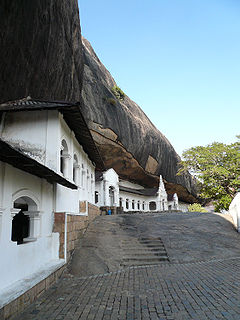
Dambulla is a town, situated in the Matale, Central Province of Sri Lanka, situated 148 km (92 mi) north-east of Colombo and 72 km (45 mi) north of Kandy. Due to its location at a major junction, it is the centre of vegetable distribution in the country.

Jaya Sri Maha Bodhi is a sacred fig tree in the Mahamewna Gardens, Anuradhapura, Sri Lanka. It is said to be the southern branch from the historical Sri Maha Bodhi at Buddha Gaya in India under which Lord Buddha attained Enlightenment. It was planted in 288 BC, and is the oldest living human-planted tree in the world with a known planting date. Today it is one of the most sacred relics of the Buddhists in Sri Lanka and respected by Buddhists all over the world.

Buddha Dordenma is a gigantic Shakyamuni Buddha statue in the mountains of Bhutan celebrating the 60th anniversary of fourth king Jigme Singye Wangchuck. The statue houses over thousands smaller Buddha statues, each of which, like the Buddha Dordenma itself, are made of bronze and gilded in gold. The Buddha Dordenma is sited amidst the ruins of Kuensel Phodrang, the palace of Sherab Wangchuck, the thirteenth Desi Druk, overlooking the East Thimphu, the capital of Bhutan. Construction began in 2006 and was planned to finish in October 2010, however construction did not conclude until 25 September 2015. The completed work is one of the largest Buddha rupas in the world, at 54 metres (177 ft) and contains 8-inch and 12-inch-tall gold gilded bronze Buddhas.

The Toluvila statue is a seated image of the Buddha discovered in 1900 in Anuradhapura, Sri Lanka, that dates back to the 4th or 5th century. Carved out of granite, it is one of the best-preserved sculptures from Sri Lanka and is similar to the Samadhi statue of Anuradhapura. Some features of the statue indicate that it may have been influenced by the Mathura School. The statue is now kept at the National Museum of Colombo.

The Avukana statue is a standing statue of the Buddha near Kekirawa in North Central Sri Lanka. The statue, which has a height of more than 40 feet (12 m), was carved out of a large granite rock face during the 5th century. It depicts a variation of the Abhaya mudra, and the closely worn robe is elaborately carved. Constructed during the reign of Dhatusena, it may have been made as a result of a competition between a master and a pupil. The Avukana statue is one of the best examples of a standing statue constructed in ancient Sri Lanka. It is now a popular tourist attraction.
The ancient Sinhalese excelled in the construction of tanks (Wevas) or reservoirs, dagobas and palaces in Sri Lanka, as evident from the ruins which displays a rich variety of architectural forms.
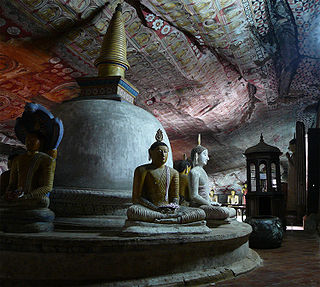
Dambulla cave temple also known as the Golden Temple of Dambulla is a World Heritage Site (1991) in Sri Lanka, situated in the central part of the country. This site is situated 148 kilometres (92 mi) east of Colombo and 72 kilometres (45 mi) north of Kandy.

Yapahuwa was one of the ephemeral capitals of medieval Sri Lanka. The citadel of Yapahuwa lying midway between Kurunagala and Anuradhapura was built around a huge granite rock rising abruptly almost a hundred meters above the surrounding lowlands.

Eight sites of Sri Lanka have been inscribed in the UNESCO World Heritage, namely, the ancient city of Polonnaruwa (1982), the ancient city of Sigiriya (1982), the Golden Temple of Dambulla (1991), the old town of Galle and its fortifications (1988), the sacred city of Anuradhapura (1982), the sacred city of Kandy (1988), Sinharaja Forest Reserve (1988) and the Central Highlands of Sri Lanka (2010).
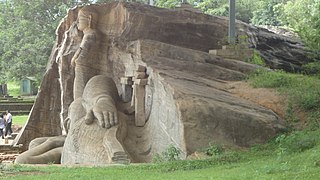
The Gal Vihara, also known as Gal Viharaya and originally as the Uttararama, is a rock temple of the Buddha situated in the ancient city of Polonnaruwa in North Central Province, Sri Lanka. It was fashioned in the 12th century by Parakramabahu I. The central feature of the temple is four rock relief statues of the Buddha, which have been carved into the face of a large granite rock. The images consist of a large seated figure, another smaller seated figure inside an artificial cavern, a standing figure and a reclining figure. These are considered to be some of the best examples of ancient Sinhalese sculpting and carving arts, and have made the Gal Vihara the most visited monument at Polonnaruwa.

Buduruwagala is an ancient buddhist temple in Sri Lanka. The complex consists of seven statues and belongs to the Mahayana school of thought. The statues date back to the 10th century. The gigantic Buddha statue still bears traces of its original stuccoed robe and a long streak of orange suggests it was once brightly painted. The central of the three figures to the Buddha's right is thought to be the Buddhist mythological figure-the Bodhisattva Avalokitesvara. To the left of this white painted figure is a female figure in the thrice-bent posture, which is thought to be his consort-Tara.

Kala Wewa, built by the King Datusena in 307 B.C, is a twin reservoir complex which has a capacity of 123 million cubic meters. This reservoir complex has facilitated with a stone made spillway and three main sluices. From the central major sluice, a 40 feet wide central conveys water to feed thousands of acres of paddy lands and ends at the historical capital Anuradhapura city tank Tissa Wewa meandering over 87 km (54 mi) at a slope of 6 inches per mile and is another wonder of primeval hydraulic engineering facility in ancient Ceylon.

The Maligawila Buddha statue is a standing figure of the Buddha in Sri Lanka, which has been carved out of a large limestone rock during the 7th century by a prince named Aggabodhi. It is the tallest free-standing ancient statue of the Buddha found in the country. It had been broken into several pieces by the time it was found in 1951. The statue was reconstructed and raised again in 1980 under the direction of the then president Ranasinghe Premadasa.
Monaragala electoral district is one of the 22 multi-member electoral districts of Sri Lanka created by the 1978 Constitution of Sri Lanka. The district is conterminous with the administrative district of Monaragala in the Uva province. The district currently elects 5 of the 225 members of the Sri Lankan Parliament and had 300,642 registered electors in 2010.

Wat Suan Dok, also known as Wat Buppharam is a Buddhist temple (Wat) in Chiang Mai, northern Thailand. It is a Royal Temple of the Third Class. The temple is on Suthep Road, approximately one kilometre west of Suan Dok gate at the west side of the moat.

The Sri Lanka Maha Bodhi Centre is a Sri Lankan establishment in Chennai, India. It is located in Egmore. It is run by the Sri Lanka Maha Bodhi Society and serves as a monument of friendship between Sri Lanka and India.

Seema Malaka is a Buddhist temple in Colombo, Sri Lanka. The temple is mainly used for meditation and rest, rather than for worship. Situated in the Beira Lake, the temple was originally constructed in the late 19th century. Seema Malaka is a part of the Gangaramaya Temple and is situated few hundred meters to its east.



